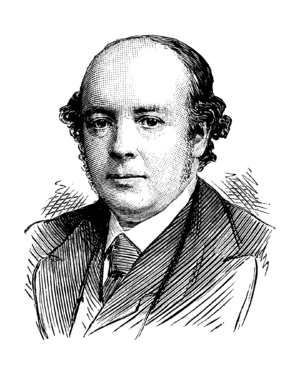Henry Woodward (geologist) facts for kids
Quick facts for kids
Henry Woodward
|
|
|---|---|
 |
|
| Born | 24 November 1832 Norwich, England
|
| Died | 6 September 1921 (aged 88) Bushey, England
|
| Known for | Invertebrate paleontology |
| Children |
|
| Awards |
|
| Scientific career | |
| Fields | Geology, Paleontology |
| Institutions | British Museum of Natural History |
Henry Bolingbroke Woodward (born November 24, 1832 – died September 6, 1921) was an English scientist. He was a geologist, who studies Earth's rocks and history, and a paleontologist, who studies ancient life through fossils. He was especially known for his work on fossil crustaceans (like crabs and lobsters) and other arthropods (insects, spiders, etc.).
Who Was Henry Woodward?
Henry Woodward was born in Norwich, England, on November 24, 1832. He went to school there at Norwich School. He grew up to become a very important figure in the study of fossils.
His Amazing Career
In 1858, Henry Woodward started working at the British Museum. He was an assistant in the geology department. By 1880, he became the keeper of that department. This meant he was in charge of all the geological collections.
He was recognized for his hard work and knowledge. In 1873, he became a Fellow of the Royal Society. This is a very respected group of scientists. He also received special awards like the Murchison Medal in 1884 and the Wollaston Medal in 1906. These are top honors for geologists.
Henry Woodward was also a leader in many scientific groups. He was president of the Geological Society of London from 1894 to 1896. He also led the Geologists' Association and the Palaeontographical Society.
What He Studied
Henry Woodward spent a lot of time studying fossil crustaceans. These are creatures like ancient crabs, lobsters, and shrimp. He also studied other arthropods, which include insects, spiders, and centipedes.
He wrote important books about his findings. One famous work was Monograph of the British Fossil Crustacea, Order Merostomata. He also wrote about Carboniferous Trilobites. Trilobites were ancient sea creatures that are now extinct.
From 1864, he was the editor of the Geological Magazine. This was a major science journal. He helped share new discoveries with other scientists for many years. His collections of shells and fossil casts are now kept at the Cambridge University Museum of Zoology.
His Family
Henry Woodward came from a family of scientists and scholars. His father, Samuel Woodward, was also a well-known geologist. His brother, Samuel Pickworth Woodward, became a professor of geology.
Henry's nephews also followed in the family's footsteps. Bernard Barham Woodward was a malacologist, someone who studies mollusks like snails and clams. Horace Bolingbroke Woodward was also a respected geologist.
Henry Woodward had two sons and five daughters. His eldest son, Henry Page Woodward, became a geologist and worked in Australia. His second son, Martin, was a promising zoologist. Sadly, Martin was lost at sea during a boat trip.
Two of Henry's daughters became talented artists. Alice B. Woodward and Gertrude Mary Woodward created amazing biological illustrations. Alice was also famous for illustrating children's books.

